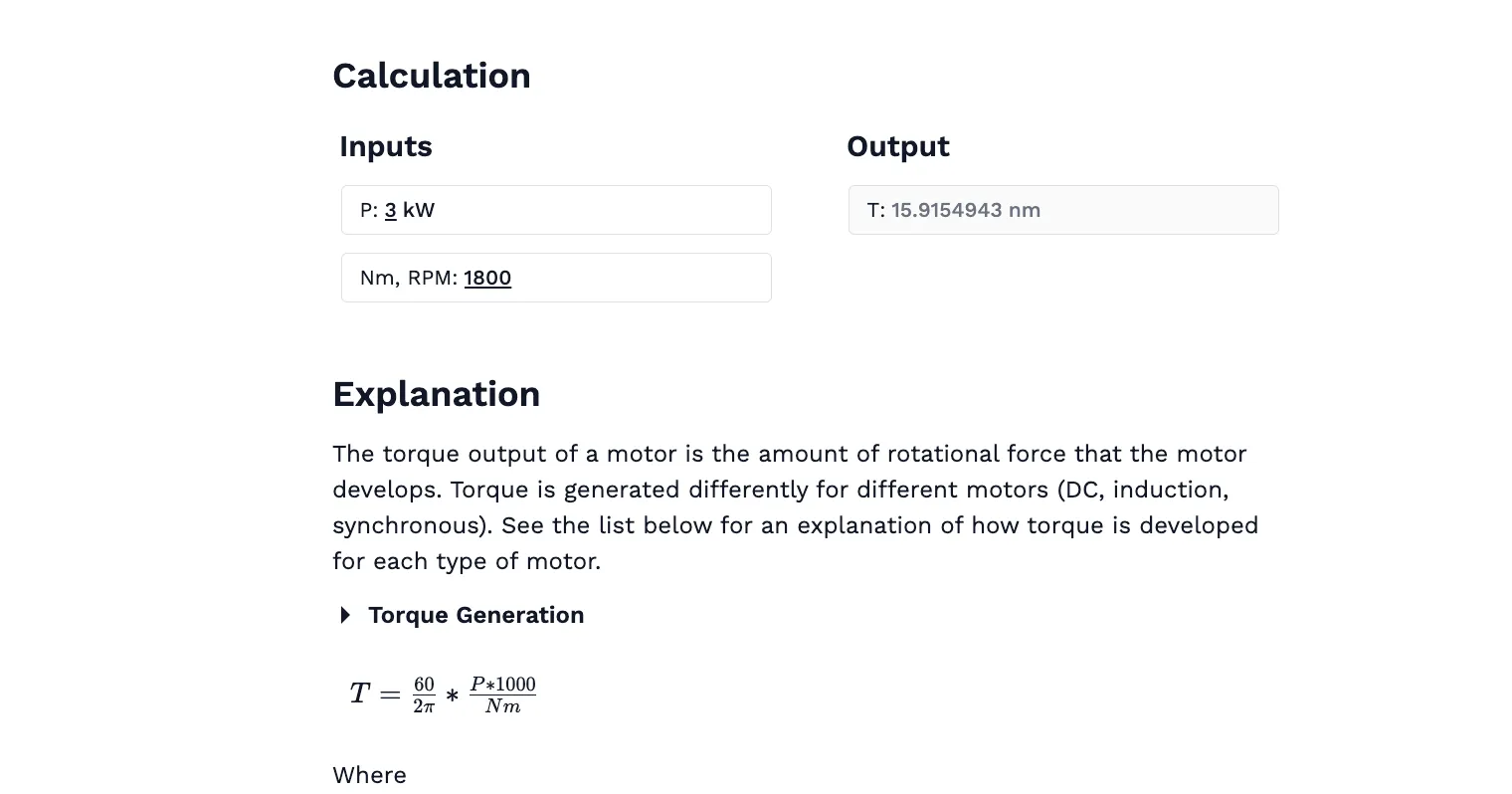Free Electric Motor Torque Calculator. Step-by-step, engineering-grade tool with downloadable report.

This template is not available yet. You can sign up and create it yourself!
Or let us know if you'd like to be notified when it’s ready:
About this 'Electric Motor Torque Calculator'
This Electric Motor Torque Calculator is designed to help you easily calculate the torque of an electric motor by inputting the motor speed and power rating. Torque, speed, and power are interrelated properties, and understanding this relationship is crucial when selecting the appropriate motor for any application. This tool allows users to quickly assess whether a motor’s torque is suitable for specific performance requirements. By inputting values such as rated power (in watts, kilowatts, or horsepower) and rated speed (in RPM), the calculator outputs torque in newton-meters \(Nm\), offering a fast and reliable method for feasibility checks or design validation.
This calculator is for:
- Mechanical engineers involved in designing systems with electric motors for various applications.
- Electrical engineers selecting motors for energy-efficient systems.
- Technicians performing performance checks or troubleshooting issues in motor-driven equipment.
The calculator provides quick feasibility checks for motor selection, ensuring that the torque output aligns with design needs or operational conditions. The formula for calculating torque is:
$$Torque (Nm) = \frac{(\text{Power (W)} \times 60)}{2\pi \times \text{Speed (RPM)}}$$
Note: When entering input parameters, the motor's rated power, motor's rated speed, and other specifications are typically found on the motor's datasheet or nameplate. The motor rating (rated power) and rated speed are essential for accurate calculations.
The rated speed is not the synchronous speed; remember, the difference between synchronous speed and actual shaft speed (slip) is important for understanding motor performance. Synchronous speed is determined by the supply frequency and the number of poles, and the difference (slip) between synchronous speed and actual speed affects torque output.
Slip can be expressed as a \({Slip} = \frac{\text{Synchronous Speed} - \text{Actual Speed}}{\text{Synchronous Speed}}\)
This variation affects both torque output and the motor’s efficiency. Torque, as a vector quantity, defines the motor’s ability to produce rotational force. Its magnitude reflects the maximum load capacity, while its direction indicates the direction of rotation. These characteristics are essential when evaluating a motor’s performance under load.
In practical applications—such as conveyors, fans, or electric aircraft—torque must match the mechanical demands of the system. Accurately calculating torque ensures the selected motor can maintain performance and reliability. While it’s possible to perform these calculations manually using torque-speed-power relationships and conversion factors, this approach can be time-consuming and error-prone. The calculator streamlines the process, improving speed and accuracy.
Introduction to Motor Torque
Motor torque is the rotational force delivered at the motor shaft and is the key factor in determining whether a motor can handle a given mechanical load. Measured in newton-meters (Nm), torque directly corresponds to a motor’s ability to drive or resist rotational motion. It is a product of motor power and rotational speed, governed by physics principles that apply across all electric motor types—whether AC, DC, induction, or synchronous machines.
By inputting the motor’s rated power (in kilowatts or horsepower) and its rated speed (in revolutions per minute, or rpm), users can calculate the torque using the formula: \( T = \frac{60}{2\pi} \times \frac{P \times 1000}{N} \) where T is the torque in newton-meters, P is the rated power, and N is the rated speed. This equation allows for a straightforward calculation of the motor’s torque, ensuring that the selected motor will meet the mechanical power requirements of the application.
As motor speed increases, torque decreases if the power remains constant, and vice versa. This inverse relationship is important when choosing a motor, as it directly impacts the motor’s ability to deliver the necessary rotational force for a given task.
In addition to torque, other important parameters include the motor’s rated speed, rated power, and efficiency. The rated speed is the operational speed of the motor, usually given in rpm, while the rated power indicates the maximum mechanical power output, measured in kW or hp. Efficiency measures how effectively the motor converts electrical power into mechanical power, with higher efficiency meaning less energy is lost during operation.
Calculating electric motor torque can also involve variables such as current, voltage, and efficiency. For example, the formula \( t = \frac{\frac{I \times V \times E}{100 \times 60}}{\text{rpm} \times 2 \times \pi} \) takes into account the electrical input and the motor’s efficiency to provide a more detailed measure of torque output.
In summary, motor torque is one of the most important parameters when designing or evaluating electric motor systems. It defines load capacity, governs acceleration, and affects energy use. By calculating and verifying torque, engineers ensure that motors are selected properly and perform as intended in a range of applications.
Engineering templates
Common calculators
Design guides
FAQs
How are motor torque, speed, and power related?
Motor torque, speed, and power are directly proportional. If the speed of a motor increases while maintaining the same power, the torque decreases and vice versa. This relationship is fundamental to motor performance.
What factors affect the torque output of an electric motor?
The torque output of a motor depends on several factors, including the power rating, speed, voltage, and load conditions. These factors must be considered when selecting a motor for a particular application.
Why is torque an important consideration in motor selection?
Torque determines the motor's ability to perform mechanical work. Motors with insufficient torque may struggle to start or maintain operation under load, making it critical to choose a motor with adequate torque for the application.
References
For a deeper understanding of motor torque and related calculations, “Electric Motors and Drives: Fundamentals, Types and Applications” by Austin Hughes is an excellent resource that explains the theory behind electric motor behavior and selection criteria.
Learn about the benefits of using CalcTree on engineering projects!


